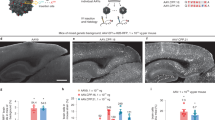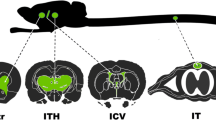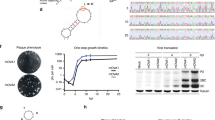Abstract
Inflammation and immune reaction, or pre-existing immunity towards commonly used viral vectors for gene therapy severely impair long-term gene expression in the central nervous system (CNS), impeding the possibility to repeat the therapeutic intervention. Here, we show that injection of a helper-dependent adenoviral (HD-Ad) vector by lumbar puncture into the cerebrospinal fluid (CSF) of non-human primates allows long-term (three months) infection of neuroepithelial cells, also in monkeys bearing a pre-existing anti-adenoviral immunity. Intrathecal injection of the HD-Ad vector was not associated with any sign of systemic or local toxicity, nor by signs of a CNS-specific immune reaction towards the HD-Ad vector. Injection of HD-Ad vectors into the CSF circulation may thus represent a valuable approach for CNS gene therapy allowing for long-term expression and re-administration.
This is a preview of subscription content, access via your institution
Access options
Subscribe to this journal
Receive 12 print issues and online access
$259.00 per year
only $21.58 per issue
Buy this article
- Purchase on Springer Link
- Instant access to full article PDF
Prices may be subject to local taxes which are calculated during checkout



Similar content being viewed by others
References
Kaplitt MG, Feigin A, Tang C, Fitzsimons HL, Mattis P, Lawlor PA et al. Safety and tolerability of gene therapy with an adeno-associated virus (AAV) borne GAD gene for Parkinson's disease: an open label, phase I trial. Lancet 2007; 369: 2097–2105.
Medawar P . Immunity to homologous grafted skin. III. The fate of skin homografts transplanted to the brain, to subcutaneous tissue, and to the anterior chamber of the eye. Br J Exp Pathol 1948; 29: 58–69.
Lowenstein PR, Castro MG . Inflammation and adaptive immune responses to adenoviral vectors injected into the brain: peculiarities, mechanisms, and consequences. Gene Therapy 2003; 10: 946–954.
Regardsoe EL, McMenamin MM, Charlton HM, Wood MJ . Local adenoviral expression of Fas ligand upregulates pro-inflammatory immune responses in the CNS. Gene Therapy 2004; 11: 1462–1474.
Tada T, Nguyen JB, Hitoshi Y, Watson NP, Dunn JF, Ohara S et al. Diffuse encephaloventriculitis and substantial leukoencephalopathy after intraventricular administration of recombinant adenovirus. Neurol Res 2005; 27: 378–386.
Thomas CE, Schiedner G, Kochanek S, Castro MG, Lowenstein PR . Peripheral infection with adenovirus causes unexpected long-term brain inflammation in animals injected intracranially with first-generation, but not with high-capacity, adenovirus vectors: toward realistic long-term neurological gene therapy for chronic diseases. Proc Natl Acad Sci USA 2000; 97: 7482–7487.
Thorner AR, Vogels R, Kaspers J, Weverling GJ, Holterman L, Lemckert AA et al. Age dependence of adenovirus-specific neutralizing antibody titers in individuals from sub-Saharan Africa. J Clin Microbiol 2006; 44: 3781–3783.
Thomas CE, Schiedner G, Kochanek S, Castro MG, Lowenstein PR . Pre-existing antiadenoviral immunity is not a barrier to efficient and stable transduction of the brain, mediated by novel high-capacity adenovirus vectors. Hum Gene Therapy 2001; 12: 839–846.
Chou AK, Yang LC, Wu PC, Wong WT, Liu GS, Chen JT et al. Intrathecal gene delivery of glial cell line-derived neurotrophic factor ameliorated paraplegia in rats after spinal ischemia. Brain Res Mol Brain Res 2005; 133: 198–207.
Driesse MJ, Esandi MC, Kros JM, Avezaat CJ, Vecht C, Zurcher C et al. Intra-CSF administered recombinant adenovirus causes an immune response-mediated toxicity. Gene Therapy 2000; 7: 1401–1409.
Martino G, Furlan R, Comi G, Adorini L . The ependymal route to the CNS: an emerging gene-therapy approach for MS. Trends Immunol 2001; 22: 483–490.
Poliani PL, Brok H, Furlan R, Ruffini F, Bergami A, Desina G et al. Delivery to the central nervous system of a nonreplicative herpes simplex type 1 vector engineered with the interleukin 4 gene protects rhesus monkeys from hyperacute autoimmune encephalomyelitis. Hum Gene Therapy 2001; 12: 905–920.
Takada J, Ooboshi H, Ago T, Kitazono T, Yao H, Kadomatsu K et al. Postischemic gene transfer of midkine, a neurotrophic factor, protects against focal brain ischemia. Gene Therapy 2005; 12: 487–493.
Chen HH, Mack LM, Kelly R, Ontell M, Kochanek S, Clemens PR . Persistence in muscle of an adenoviral vector that lacks all viral genes. Proc Natl Acad Sci USA 1997; 94: 1645–1650.
Callard R, Gearing A . IL-4. In: Callard R and Gearing (eds). The Cytokine FactsBook. Academic Press: London, 1994, pp. 53–58.
Yao G, Chen W, Luo H, Jiang Q, Xia Z, Zang L et al. Identification of core functional region of murine IL-4 using peptide phage display and molecular modeling. Int Immunol 2006; 18: 19–29.
Recchia A, Parks RJ, Lamartina S, Toniatti C, Pieroni L, Palombo F et al. Site-specific integration mediated by a hybrid adenovirus/adeno-associated virus vector. Proc Natl Acad Sci USA 1999; 96: 2615–2620.
Grimaldi L, Murhty KK, Martino G, Furlan R, Franciotta D, Eichberg JW . An immunovirological study of the central nervous system involvement during HIV-1 infection of chimpanzees. J Acquir Immune Defic Syndr Hum Retrovirol 1996; 13: 12–17.
Furlan R, Poliani PL, Marconi PC, Bergami A, Ruffini F, Adorini L et al. Central nervous system gene therapy with interleukin-4 inhibits progression of ongoing relapsing–remitting autoimmune encephalomyelitis in Biozzi AB/H mice. Gene Therapy 2001; 8: 13–19.
Andersson M, Alvarez-Cermeno J, Bernardi G, Cogato I, Fredman P, Frederiksen J et al. Cerebrospinal fluid in the diagnosis of multiple sclerosis: a consensus report. J Neurol Neurosurg Psychiatry 1994; 57: 897–902.
Acknowledgements
This work was supported by grants from the Italian Multiple Sclerosis Foundation (FISM), the Myelin Project, the Cariplo Foundation and the Italian Ministry of Education and Scientific Research (MIUR-FIRB). We thank P Moullier and M Coville from the Animal Science Department of the Boisbonne Center, Nantes, for technical help and fruitful discussion.
Author information
Authors and Affiliations
Corresponding author
Rights and permissions
About this article
Cite this article
Butti, E., Bergami, A., Recchia, A. et al. Absence of an intrathecal immune reaction to a helper-dependent adenoviral vector delivered into the cerebrospinal fluid of non-human primates. Gene Ther 15, 233–238 (2008). https://doi.org/10.1038/sj.gt.3303050
Received:
Revised:
Accepted:
Published:
Issue Date:
DOI: https://doi.org/10.1038/sj.gt.3303050
Keywords
This article is cited by
-
Leptin and the maintenance of elevated body weight
Nature Reviews Neuroscience (2018)
-
IL4 induces IL6-producing M2 macrophages associated to inhibition of neuroinflammation in vitro and in vivo
Journal of Neuroinflammation (2016)
-
Readministration of helper-dependent adenoviral vectors to mouse airway mediated via transient immunosuppression
Gene Therapy (2011)
-
Progress and prospects: gene therapy for genetic diseases with helper-dependent adenoviral vectors
Gene Therapy (2008)



